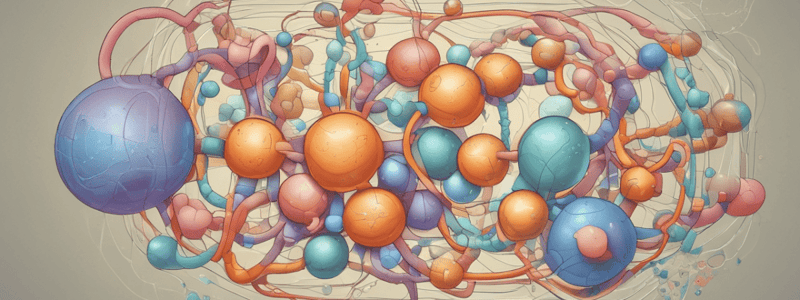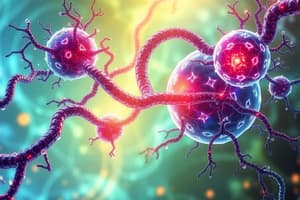Podcast
Questions and Answers
What is the primary function of ATP synthase complex in the mitochondrial matrix?
What is the primary function of ATP synthase complex in the mitochondrial matrix?
- To generate ATP from ADP and Pi (correct)
- To pump H+ ions into the intermitochondrial space
- To facilitate the electron transport chain
- To regulate mitochondrial DNA replication
What is the effect of high ATP levels on oxidative phosphorylation and electron transport?
What is the effect of high ATP levels on oxidative phosphorylation and electron transport?
- Decreased ATP synthesis and electron transport (correct)
- Increased ATP synthesis and electron transport
- No effect on ATP synthesis and electron transport
- Increased electron transport but decreased ATP synthesis
What is the primary consequence of mitochondrial dysfunction in highly-energetic tissues?
What is the primary consequence of mitochondrial dysfunction in highly-energetic tissues?
- Increased ATP synthesis and energy production
- Increased lactate production and glycolysis
- Increased mitophagy and mitochondrial biogenesis
- Decreased ATP synthesis and energy production (correct)
What is the function of uncoupling agents, such as UCP 1-5, in the electron transport chain?
What is the function of uncoupling agents, such as UCP 1-5, in the electron transport chain?
What is the effect of cyanide on the electron transport chain and glycolysis?
What is the effect of cyanide on the electron transport chain and glycolysis?
What is the primary characteristic of lipids in terms of solubility?
What is the primary characteristic of lipids in terms of solubility?
What is the effect of low ADP levels on the electron transport chain and ATP synthesis?
What is the effect of low ADP levels on the electron transport chain and ATP synthesis?
What is the consequence of mitochondrial dysfunction in terms of patient safety?
What is the consequence of mitochondrial dysfunction in terms of patient safety?
What is the primary function of the electron transport chain in the mitochondria?
What is the primary function of the electron transport chain in the mitochondria?
Which of the following is a characteristic of oxidative phosphorylation?
Which of the following is a characteristic of oxidative phosphorylation?
What is the result of proton translocation during electron transport?
What is the result of proton translocation during electron transport?
What is the role of ATP utilisation in the regulation of the citric acid cycle?
What is the role of ATP utilisation in the regulation of the citric acid cycle?
What is the effect of uncoupling agents on oxidative phosphorylation?
What is the effect of uncoupling agents on oxidative phosphorylation?
What is the site of ATP synthesis during oxidative phosphorylation?
What is the site of ATP synthesis during oxidative phosphorylation?
What is the result of a high NADH/NAD+ ratio in the citric acid cycle?
What is the result of a high NADH/NAD+ ratio in the citric acid cycle?
What is the role of oxygen in the electron transport chain?
What is the role of oxygen in the electron transport chain?
What is the primary function of the tricarboxylic acid cycle in the context of carbohydrate catabolism?
What is the primary function of the tricarboxylic acid cycle in the context of carbohydrate catabolism?
What is the consequence of a deficiency in pyruvate dehydrogenase (PDH) in carbohydrate catabolism?
What is the consequence of a deficiency in pyruvate dehydrogenase (PDH) in carbohydrate catabolism?
What is the reactant required for the conversion of pyruvate to acetyl-CoA?
What is the reactant required for the conversion of pyruvate to acetyl-CoA?
What is the byproduct of the tricarboxylic acid cycle that is used in biosynthesis?
What is the byproduct of the tricarboxylic acid cycle that is used in biosynthesis?
What is the energy status of the cell that regulates the conversion of pyruvate to acetyl-CoA?
What is the energy status of the cell that regulates the conversion of pyruvate to acetyl-CoA?
What is the location of the tricarboxylic acid cycle in the context of carbohydrate catabolism?
What is the location of the tricarboxylic acid cycle in the context of carbohydrate catabolism?
Flashcards are hidden until you start studying
Study Notes
Stage 3: Tricarboxylic Acid Cycle (TCA Cycle)
- Occurs in mitochondria
- Requires NAD+, FAD, and oxaloacetate
- Breaks the C-C bond in acetate (as acetyl CoA) and oxidizes the C-atoms to CO2, which is released
- H+ and e- removed from acetate are transferred to NAD+ and FAD (NADH and FADH2 produced)
- Requires oxygen
- Produces ATP and GTP (energy)
- Some reactions are irreversible
Stage 4: Oxidative Phosphorylation (OXPHOS)
- Converts chemical energy from nutrients into ATP
- Energy conserved in reduced carriers (NADH and FADH2) is used to synthesize ATP
- Two processes: electron transport and ATP synthesis
- Occurs inside the mitochondria, specifically in the invaginations of the inner membrane
- Electron transport: transfer of electrons to molecular oxygen mediated by four specialized complexes (I-IV)
- Electrons come from NADH and FADH2, shuttled to the intermembrane space
- Proton translocation results in "proton-motive force" (also referred to as electro-chemical potential)
- Requires oxygen: reduced to water at complex IV
Regulation of OXPHOS
- Normally oxidative phosphorylation and electron transport are tightly coupled
- Both regulated by mitochondrial ATP
- High ATP = Low ADP
- When ADP is low: no substrate for ATP synthase, inward flow of H+ stops, and concentration of H+ in the intermitochondrial space increases
- Prevents further H+ pumping, stopping electron transport
- Reverses with low ATP
Clinical Relevance
- Mitochondrial dysfunction: loss of efficiency in the electron transport chain and reductions in the synthesis of ATP
- Linked to most human conditions in highly-energetic tissues (e.g., brain, neurodegeneration)
- Mitochondrial DNA mutations: abnormal components of the respiratory chain
- Uncouplers and inhibitors: uncoupling agents (UCP 1-5) important for heat production, inhibitors (poisons) stop ATP and heat production
Lipids
- Generally insoluble in water (hydrophobic) but soluble in organic solvents
- Most contain only C, H, and O (phospholipids also contain P and N)
- More reduced than carbohydrates
Catabolism of Carbohydrates
- Stage 2: pyruvate is converted to acetyl CoA by pyruvate dehydrogenase (PDH) - regulated allosterically
- Reaction is irreversible (pyruvate loses one C-atom)
- Sensitive to the energy status of the cell
- Deficiencies of PDH: X-linked dominant disorder leading to lactic acidemia - Leigh's disease (necrotizing encephalopathy)
Studying That Suits You
Use AI to generate personalized quizzes and flashcards to suit your learning preferences.



